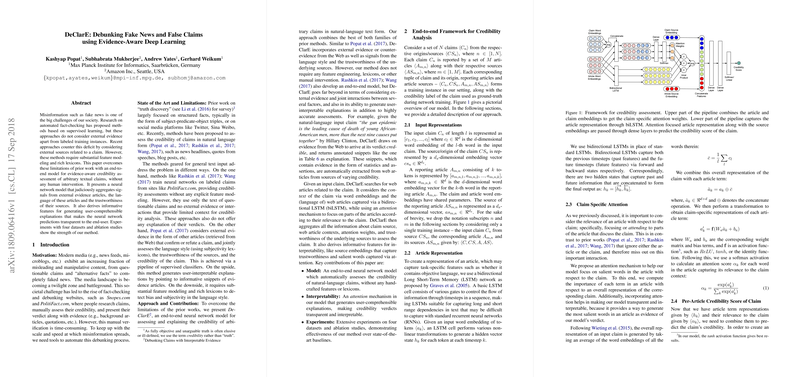Overview of "DeClarE: Debunking Fake News and False Claims Using Evidence-Aware Deep Learning"
The paper "DeClarE: Debunking Fake News and False Claims Using Evidence-Aware Deep Learning" presents a sophisticated approach to address the pervasive problem of misinformation and fake news in modern media. The authors propose an innovative end-to-end neural network model, DeClarE, designed to assess the credibility of various textual claims by leveraging evidence-aware methods without the need for human intervention or hand-crafted features.
Key Contributions
DeClarE is distinguished from previous models by its comprehensive approach that integrates external evidence, the stylistic language of articles, and the reliability of sources to assess claim credibility. The main contributions of this work can be summarized as follows:
- End-to-End Model: The model operates without the necessity for feature engineering, relying instead on automated deep learning techniques to analyze and interpret data associated with claims.
- Evidence Integration: Unlike prior models, which often rely solely on the textual claim itself or require elaborate feature models, DeClarE incorporates information from external web articles. This allows the model to execute a more contextually aware credibility assessment, combining both language style analysis and source trustworthiness.
- User Interpretability: The model features an attention mechanism that provides user-comprehensible explanations for its credibility assessments, enhancing transparency by indicating which parts of the evidence significantly contributed to the decision.
- Strong Experimental Results: Using extensive experimentation across four datasets, DeClarE demonstrates robust performance, showcasing superiority over existing state-of-the-art models. The analysis included a variety of benchmarks, from the general fact-checking context to specific political claims.
Technical Approach
The proposed DeClarE model incorporates several advanced methods in its framework:
- Bi-Directional LSTM (biLSTM): This component captures context by processing input sequences in both forward and backward directions, enhancing the model's ability to understand the article's language and contextual associations.
- Attention Mechanism: The attention mechanism is critical for identifying the significant parts of an article concerning a claim. It computes attention weights to focus on salient words, thereby making the model's predictions not only accurate but also interpretable.
- Source Embeddings: By using embeddings for claims and article sources, the model is able to ascertain the reliability of the information sources, which is crucial for determining overall claim credibility.
Implications and Future Directions
The DeClarE model offers significant implications for both practical applications and theoretical advancements in AI-driven credibility assessment. On a practical level, automated systems like DeClarE could dramatically increase the efficiency and scalability of fact-checking processes, a critical need given the rapid proliferation of misinformation online.
From a theoretical perspective, DeClarE illustrates the efficacy of integrating external evidence with deep learning for complex language tasks, suggesting new directions for AI models to understand context and veracity. Future advancements could refine the model's interpretability features further, allowing even more granular understanding of decision-making processes in neural networks. Additionally, extending this model to handle multimedia content or incorporate real-time data streams could broaden its applicability in various domains.
In conclusion, the paper presents a significant advancement in the field of automated fact-checking and serves as an exemplar for how neural networks can be harnessed to tackle societal challenges presented by misinformation.
